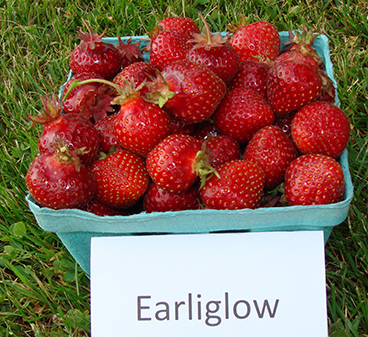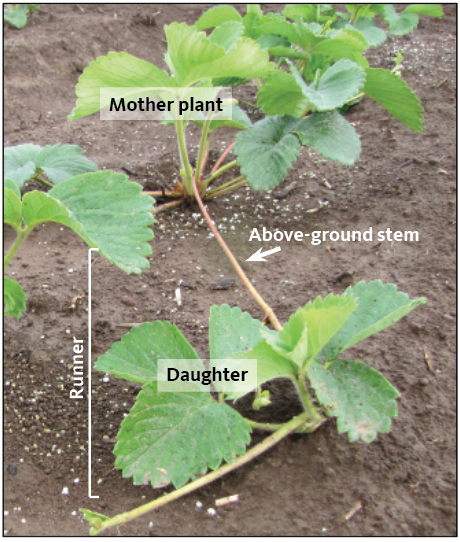For the Best Strawberries – Grow Them Yourself!
By Janet Scheren, Fairfax Master Gardener Intern

Albion Strawberry
There are three true strawberry types (Fragaria x ananassa), plus the alpine strawberry (Fragaria vesca), which is a totally different species. Depending on your needs and the time of year you want your main harvest, you may decide to plant one or more of these varieties. All are suitable for our Zone 7 climate.

Earliglow Strawberry
Popular June-bearing varieties with good disease resistance that are recommended by the Virginia Cooperative Extension include:
- ‘Camino Real’ is a compact plant with dark fruit and good disease resistance.
- ‘Camarosa’ has good disease resistance but is susceptible to verticillium wilt. Fruit is large, firm and holds well in the rain.
- ‘Delmarvel’ has large berries, good aroma and flavor. Plants are disease-resistant (except for Rhizoctonia, a type of root rot) with good winter hardiness.
- ‘Earliglow’ is a superior dessert quality berry, good for eating fresh, freezing and using in jams and jellies. The plants bloom early and, thus, are subject to frost injury.
Day-neutral strawberries are great for gardens with limited space. Their fruit is smaller than June-bearing varieties and crops are less abundant, but they are able to produce flowers and fruit throughout the growing season beginning as early as May. They are regarded as improved, more productive everbearing-type strawberries. Day-neutral strawberries are not strongly influenced by day length, so they continue to bear fruit throughout the summer as days become longer. They typically have a second smaller crop mid-season depending on heat and resume fruiting in late summer until the first hard frost. Be sure to mulch them well with heavy straw or white plastic during hot summer weather. Their roots are particularly sensitive to high soil temperatures.
Everbearing strawberries produce an early crop in spring and a second smaller crop in the fall. On the positive side, they are easy to contain as they don’t produce as many runners as the other true strawberries. However, their lower yields and fruit quality have made the day-neutral strawberries more popular.
Disease resistant, day-neutral varieties recommended by the Virginia Cooperative Extension include:
- ‘Albion’ has a dark red hue and a sweet flavor. It’s good for fresh consumption as well as processing.
- ‘San Andreas’ pairs outstanding flavor and exceptional appearance. This variety is suitable for fresh market, processing and home gardens.
Two day-neutral varieties recommended by the University of Maryland Extension are:
- ‘Tristar’ is a sweet, medium-size fruit with good disease resistance. It’s most productive in the fall.
- ‘Tribute’ is a vigorous, disease-resistant plant with medium-size berries. Its flavor is somewhat acidic.
Day-neutral and everbearing strawberries are typically planted with the hilling or mounding system. This allows you to easily remove all runners, while providing the support for the larger crowns needed to concentrate energy and maximum fruit production and quality. Day-neutral and everbearing types benefit from a monthly feeding in June, July and August. Seaweed or fish emulsion are good options for all types.

Alpine Strawberries
A few of the most popular alpine strawberries include:
- ‘Alexandria’ is top rated for flavor, vigor and yield.
- ‘Mignonette’ fruits from seed the first summer and produces all season long.
- ‘Yellow Wonder’ berries are incredibly sweet, and their yellow skin and flesh make them less attractive to birds.
Except for the alpine variety, strawberry plants require 8 to 10 hours of sun. They perform best when placed in well-drained, fertile, slightly acidic soil enriched by compost. An easy way to achieve this is with a raised bed, which also keeps the soil drained and reduces the risk of fungal disease. Strawberries can also thrive in containers.
Plant strawberries in rich soil with the roots spread out at a planting depth that sets the base of the bud at soil level. Virginia Cooperative Extension recommends applying 4 lbs. of 10-10-10 fertilizer per 100 linear feet of row two to three weeks before planting. If planting in the fall, fertilize again in spring. Because strawberries are shallow rooted, they are vulnerable to drought. Be sure they receive 1 inch of water a week, which is standard for most garden beds. They should be mulched up to 4 or 5 inches with straw or pine much during the winter to help maintain a consistent winter temperature and prevent premature budding in spring.
 Be patient with strawberries. Give them time to grow into well-established plants about the size of a salad plate by pinching off flowers and runners for the first season. Alpine strawberries, however, don’t produce runners but instead grow ever larger mounds topping out at about 10 to 12 inches wide. Once the plants are well established, strawberries are typically ready to harvest around 28 to 30 days after reaching full bloom. Do a taste test to ensure ripeness or pick berries when they are fully colored. You can prolong their shelf life by leaving the green caps on, keeping picked berries out of the sun and refrigerating them as soon as possible. Don’t wash or trim them until right before you are ready to use them.
Be patient with strawberries. Give them time to grow into well-established plants about the size of a salad plate by pinching off flowers and runners for the first season. Alpine strawberries, however, don’t produce runners but instead grow ever larger mounds topping out at about 10 to 12 inches wide. Once the plants are well established, strawberries are typically ready to harvest around 28 to 30 days after reaching full bloom. Do a taste test to ensure ripeness or pick berries when they are fully colored. You can prolong their shelf life by leaving the green caps on, keeping picked berries out of the sun and refrigerating them as soon as possible. Don’t wash or trim them until right before you are ready to use them.
Strawberries, like other members of the Rosaceae or rose family, are susceptible to a variety of bacteria, fungi, molds, viruses and a host of pests. Some basic strategies will help avoid problems with strawberries including:
- Avoid planting strawberries where potatoes, tomatoes, peppers or black raspberries have grown.
- Pick a location that is well-drained. Good soil drainage prevents standing water and makes it difficult for fungus to remain in contact with strawberries long enough to infect them.
- Use a thick barrier of mulch to prevent the spread of disease and keep the berries from contacting fungus in the soil.
- Plant strawberries in full sun to minimize conditions favorable to fungal infection and ensure good air circulation to help leaves dry quickly after rain or watering. Planting parallel to prevailing wind helps here as well.
- Harvest fruit often and early in the day. Removing the strawberries as soon as plants dry in the day can reduce infection. Harvest fruit as soon as it is fully ripe to keep brown spots and leather rot from setting in as well as to deter a variety of pests that are attracted by over-ripe fruit.
- Additionally, avoid planting strawberries where grass has grown to avoid damage from grubs.
- Cover ripening fruit with bird netting to be sure you’ll have plenty to keep for yourself.
Resources
• Strawberry Variety Trial 2016-17, Jayesh B. Samtani, Virginia Cooperative Extension Hampton Roads
• Small Fruit in the Home Garden, Jayesh B. Samtani, Reza Rafie, Tony K. Wolf and Alson H. Smith, Jr.,
Virginia Cooperative Extension
• Strawberries — Selection, Planting, Training, University of Maryland Extension
• Homegrown Berries, 2014, Timber Press Growing Guide